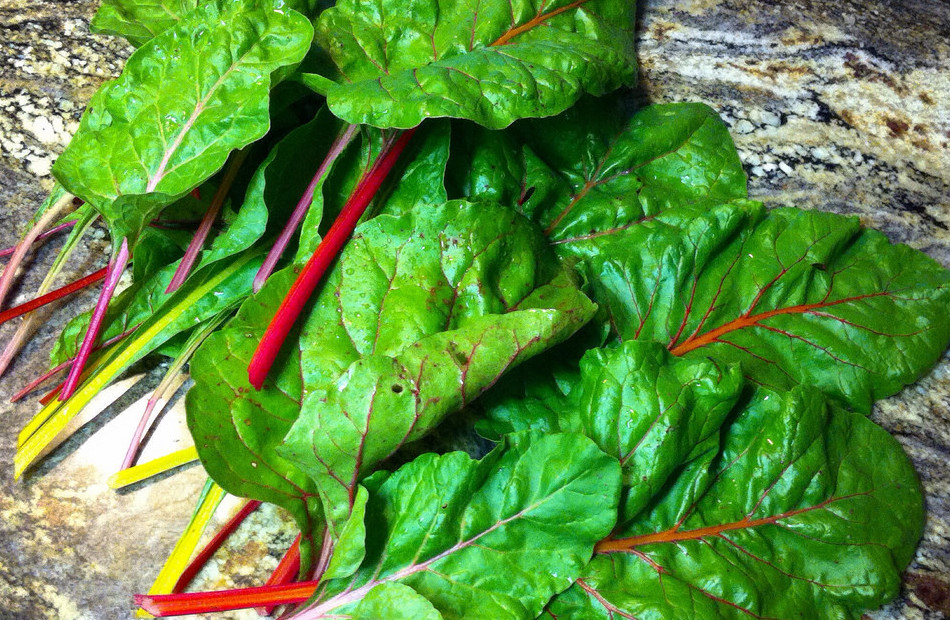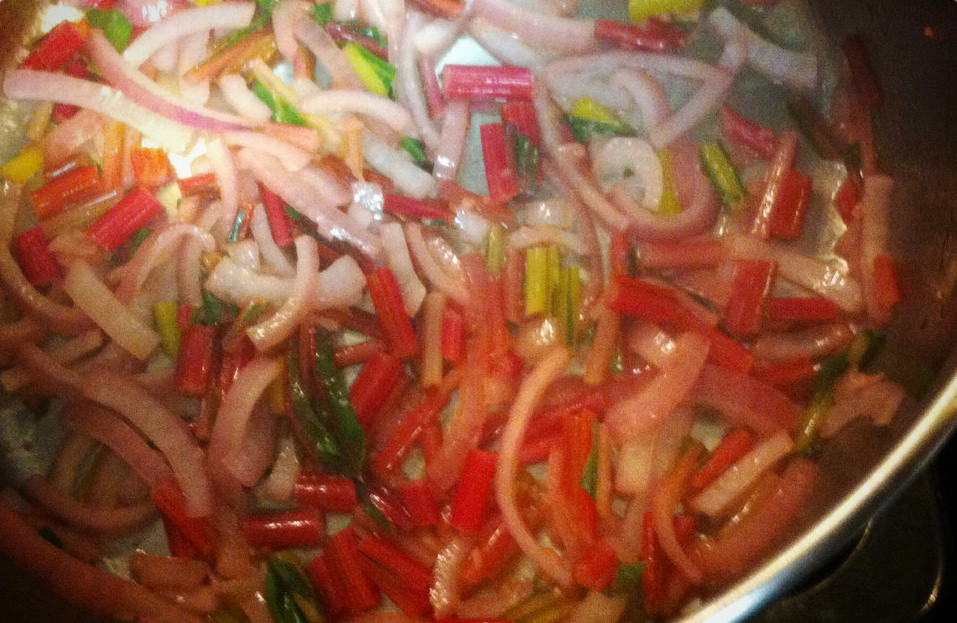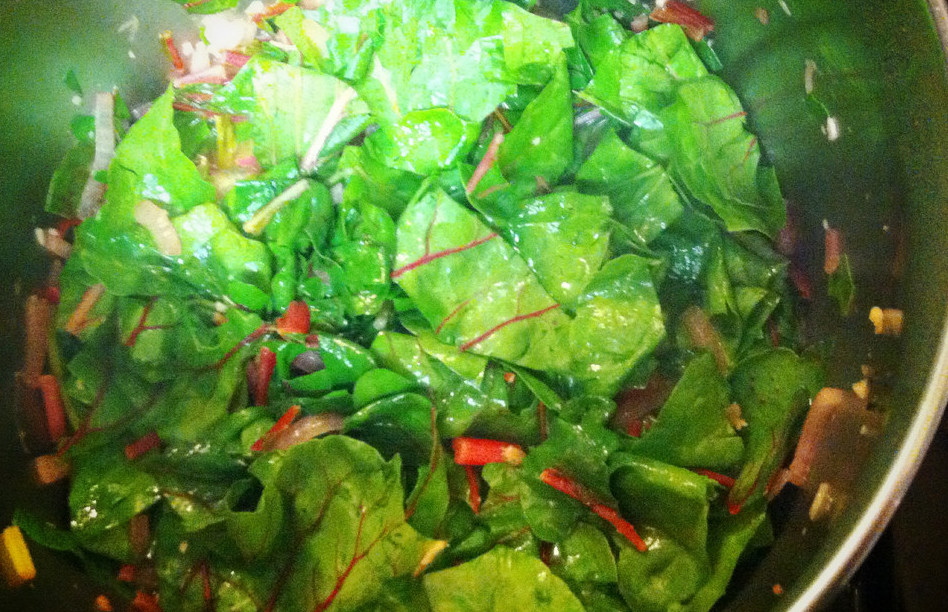
I had a small plot of Five Color Silverbeet Swiss Chard that took forever to sprout. The fact that it has ‘beet’ in the name was concerning to me. Very concerning. But I planted some anyway. I live on the backside of the danger zone, after all. I almost planted over these loser seeds thinking it was a wash. Finally, a month after I sowed, I saw a single sprout come up. As I waited for more, they sure took their sweet time. Gradually, they all made an appearance and I was happy. Living near the danger zone paid off.
These are beautiful plants. This colorful variety makes for a garden that is crying out for a plein air painter to come by and spend some quality time at the golden hour – it is lush and attractive and makes pretty pictures. Its a great crop if you like to grow your own food or like the Impressionists.
When I was a kid, occasionally they had this greenish leafy stuff festering in a vat behind the cafeteria line glass in high school. Why they ever put this stuff in front of kids, I will never know. It was probably some democrat’s fault. I knew one of the lunch ladies, Mrs. Ritter. Her husband was named Tex, a big man who worked with my dad and sold pumps for a living. He went duck hunting with us a few times and always had a stinking cigar stub peeking out from under his black mustache. That “connection” earned me bigger portions and great smiles from Mrs. Ritter. That’s when I learned, but never understood why, that networking got you benefits. I’d go through the lunch line and was met with her jovial, plump face. She would laugh with Kringle-like joy when I was the only kid out of a class of 550 that asked for liver and onions. One day she said I should try the greens.
Now this was not a thing I knew about. Greens looked like what I would dump from the lawn mower in the field behind our house, just these were boiled in water. I knew about greens. Every southern kids hears about them. But I was not raised in a true southern home, I just happened to be raised in Texas. My mom was born in Falkirk, Scotland and could make steak and kidney pie. My dad had more in common with German immigrants and swamp Cajuns than true Southerners. This meant my suburban Houston culinary experience was broad but not ethnic. It had a lot of early Tex-Mex in it.
So when I ate greens for the first time, they were public school turnip greens with little dices of root in them. I liked greens OK. I’d usually eat half of what was spooned to me, but remember I got big portions because of my “connections.” Kids looked at me funny. But man, you would always get a larger helping of the stuff no one else liked, especially with that connection. But yes, turnip greens. I still like them.
Over the years, I enjoyed many kinds of greens, southern mustard greens included, which are fantastic WITHOUT sugar. What down-home Georgia peach put sugar in her ol’ skoo greasy greens? Blech! Just give me whatever traditional southern green prepared with a ham hock, salt pork or a chunk of bacon and I’ll be happy.
But one day my Asian boss took me to China town for lunch. We went to an Asian grocer near Minute Maid Park in downtown Houston. Inside this dubious place is a little food stand and a grumpy Asian man who always seemed to have a BandAid on his thumbs. There was a giant barbecued pig hanging nose-down in this food stand and several skinny ducks, all fresh each day. They were marvelous to see! Beneath the beasts, in stainless steel pans over boiling water poachers, were all the extras. Freshly steamed rice, stocks and gravies, fetid intestines that only the true believers would order, and many kinds of greens and vegetables. We’d order the “special lunch” for $4.95 and go away with a pack of rice, pork sliced right off the pig with a huge cleaver (probably responsible for the BandAids), and a pile of steaming greens that were to die for. This was usually some sort of brassica, like Bok Choi, Pak Choi, or some sort of Asian green I don’t even know the name of. I ate lunch here once a week for many years. This place taught me that greens were a necessary staple of life, along with Asian pork, and together formed a great blessing from God. I just needed to find the varieties of greens that I liked.
One of them, besides the blissful Asian varieties, is Swiss Chard. I have had the joy of eating some of this healthy green and you should too. I found several recipes online but combined a few into my own. I don’t often use precise measurements. Feel free to adjust as you wish. Here’s what I did.
White Wine Swiss Chard
I gathered a good sized bunch of mostly young chard, not sure how to describe the volume except that the leaves filled a large mixing bowl when loosely packed. If buyin from the store, get two bunches, maybe three – greens reduce down dramatically so get more than you think you’ll need.
You will also need the following:
- 1 to 2 tablespoons of butter
- 1 tbsp or so of olive oil (keeps the butter from burning)
- Half of a small red onion, chopped in half-rings
- 2 or 3 cloves of garlic, minced or grated or mashed in a press
- Half a cup of white wine (very dry is best, but I used a Reisling, a not-0so-dry wine, and it was delicious. Always have some white wine on hand.)
- Juice of half a small lemon (limes will work too, limes are divine!)
- Salt to taste
- Half a tsp of ground red pepper (more or less to taste, you could sub a shot of Sriracha if you are using an Asian green)
- 2 tbsp of Romano/Parmesan grated cheese (more if you like, not for Asian greens though. Ever seen cheese at a Chinese buffet? No.)
In this recipe, keeping some liquids left over in your bowl makes for an almost soup-like ending. The broth is worthy of a chunk of french bread to soak up every last drop. Talk with a fake German accent if its Swiss chard you used. Makes you feel good.
Cooking
First, remove the largest stems and veins and chop them all up coarsely. Coarsely chop the greens too and set them aside. Chop up the onion coarsely as well. Using a large enough pot to contain your greens, saute the onions, minced garlic and chopped chard stems in the butter and olive oil until they begin to soften.

Once the stems are soft, add the wine and the leaves. Saute until the leaves are wilted, or just a bit longer if you prefer, 5 or 6 minutes. Turn off the heat and squeeze in the lemon juice, add the pepper and cheese, and stir in well. The cheese will give some opacity to the broth if you didn’t cook off all your liquids. And yes, I used the shaker can of Romano/Parmesan cheese blend that you keep in the fridge and shake over your spaghetti. Call me uncultured, but that’s what I had on hand and it was fine. I’ve been called worse.
Serve this delight with a crunchy french bread or as a spicy side dish.

The heat provided by the red pepper provides a nice kick and tingle, the wine gives a pleasing acid-tangy note, and the earthy chard flavors are balanced nicely. This dish was a surprisingly delicious treat.
Now, about that name, “Five Color Silverbeet Swiss Chard,” I was worried. I expected some sort of beet nightmare the first time I had chard. But it was, in fact, what I always hoped I would taste when I fought with the beet. Chard is a delicate green, worthy of any kitchen. Beats Mrs. Ritter’s public school greens by a long shot.